Select Best Annual Forages During Drought
Forage production will be below normal on pasture and hay land this year.

Yearling cattle graze on winter cereal forages in the spring. (NDSU photo)
Because drought maintains a strong foothold on the northern Plains, forage production will be below normal on pasture and hay land in 2021.
“Adding an annual forage crop may be critical to supplement your forage resources,” says Kevin Sedivec, North Dakota State University Extension rangeland management specialist.
Like perennial forages, annual forages will need rain to grow and produce biomass. What annual forages are most efficient in using water? When should you plant these forages to reduce your risk of a failed crop?
Drought-tolerant Annual Forages
Annual forages that do best during moisture-stressed periods include forage barley, forage oats and foxtail millet. Forage wheat, a newer option, also looks promising during moisture-stressed periods.
Forage barley, oats and wheat performed better under drier conditions than spring triticale in a study near Wishek, N.D., in 2020. Although forage barley and forage oats performed the best during the drought year, forage oats performed better when moisture was not limited.
How producers plan to feed the annual forage is important when selecting an annual cereal forage. If the livestock feeding operation does not have the capacity to grind feeds, forage barley will be the best option.
Forage barley has the lowest lignin content of the cereal options, creating the most palatable feed source. Forage oats are lower than forage wheat in lignin content, but both feed crops will be best fed when ground and mixed into a total mixed ration.
Siberian foxtail millet will be the best warm-season grass option during drought conditions. Although less productive than German foxtail millet, it is a better scavenger for moisture and nutrients.
A full-season cover crop mixture is also an option during drought years. This mixture could include forage cereal crops, foxtail millet and brassica species such turnips, radish, cabbage and kale. This mixture would be best suited for grazing and haylage vs. a hay crop.
The last option is planting a winter cereal. Winter cereals will not help provide extra hay in 2021 but could be used for late-season grazing or a forage option for 2022. Winter cereals are a great option for early spring grazing or early hay production.
If spring grazing is desired, use winter rye or winter triticale. If seeding a winter cereal for hay production, use winter forage wheat.
When to Seed
Seed annual cereal forages, such as forage barley or oats, as early as possible to capture the spring rains. With the warm spring, soil temperatures are approaching the required average soil temperature of 45 to 50 degrees for good germination. The risk with seeding too early is a killing freeze after germination.
Seed warm-season annual forages, such as foxtail millet, when soil temperatures are approaching the required average soil temperature of 65 degrees. Most warm-season grasses do best in warm, fertile soils.
If the plan is to add late-season grazing in 2021, a full-season cover crop or winter rye will be the best options. Seed the full-season cover crop by mid-June and when soil moisture is not low. Seed the winter rye from mid-August to mid-September and after receiving moisture to assure successful germination and growth.
“Irrelevant of which annual forage you choose, timing of seeding will be critical this year,” says Miranda Meehan, NDSU Extension livestock environmental stewardship specialist. “Soil moisture levels are extremely low, so moisture following seeding will be needed to assure germination and above-ground growth.”
Incorporating an annual forage crop can provide supplemental feed and give producers a bit more management flexibility if the drought persists, according to the specialists. Contact a local Extension agent for more information on annual forage options or drought planning.
NDSU Agriculture Communication - April 6, 2021
Source: Kevin Sedivec, 701-424-3606, kevin.sedivec@ndsu.edu
Source: Miranda Meehan, 701-231-7683, miranda.meehan@ndsu.edu
Editor: Ellen Crawford, 701-231-5391, ellen.craweford@ndsu.edu
